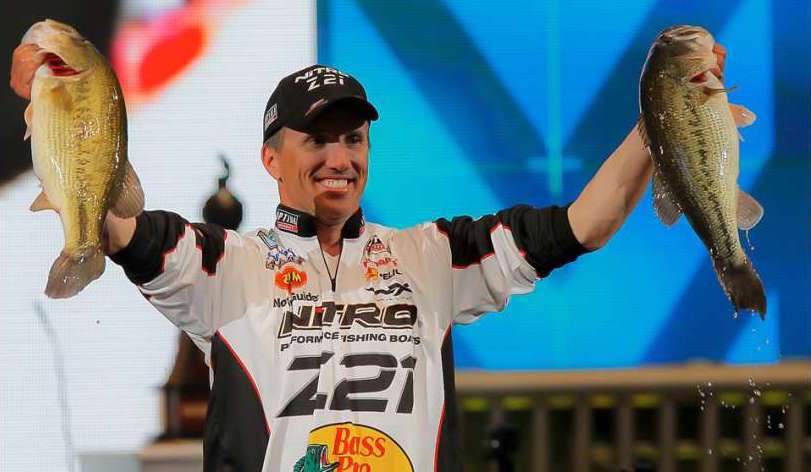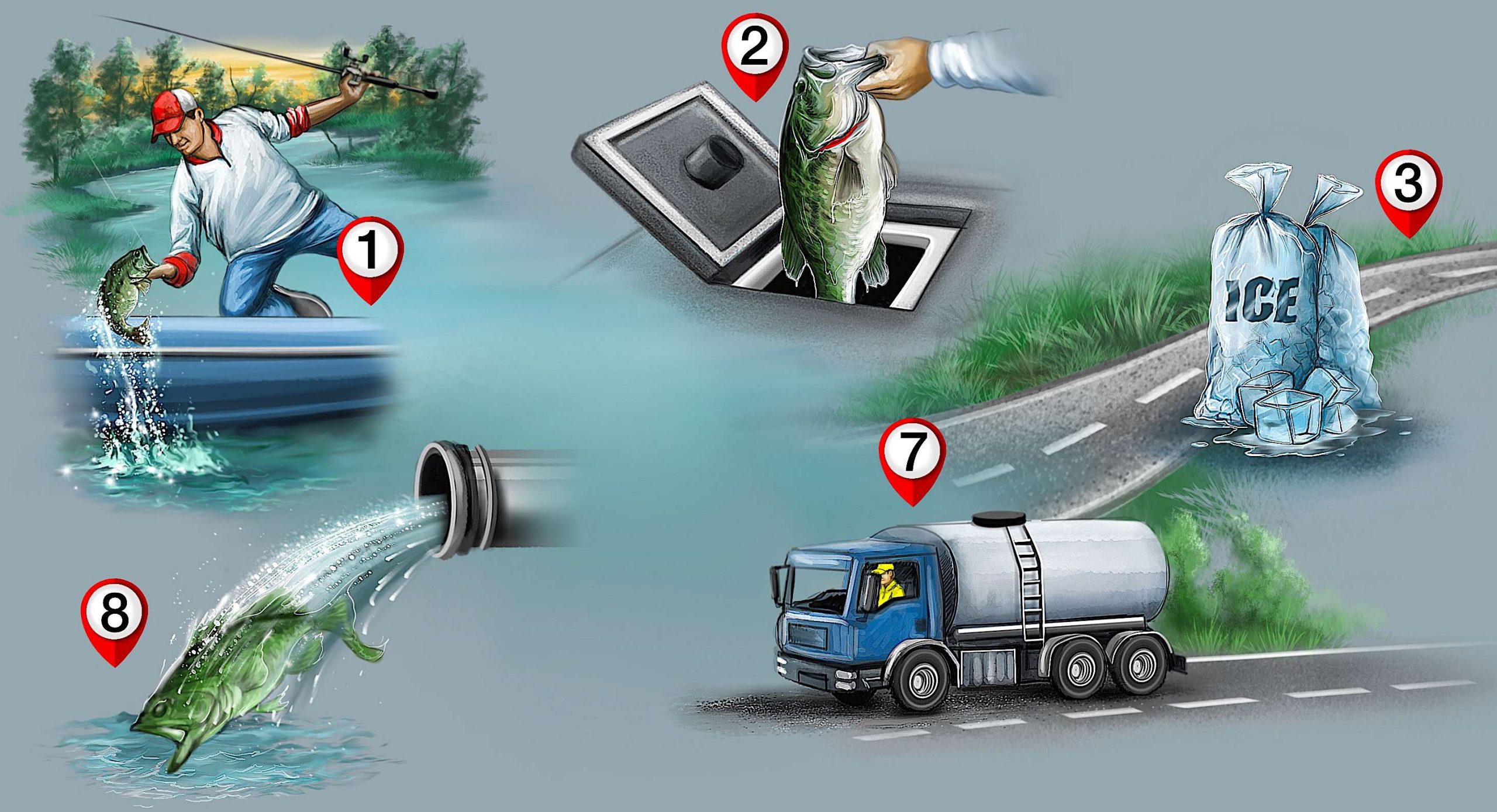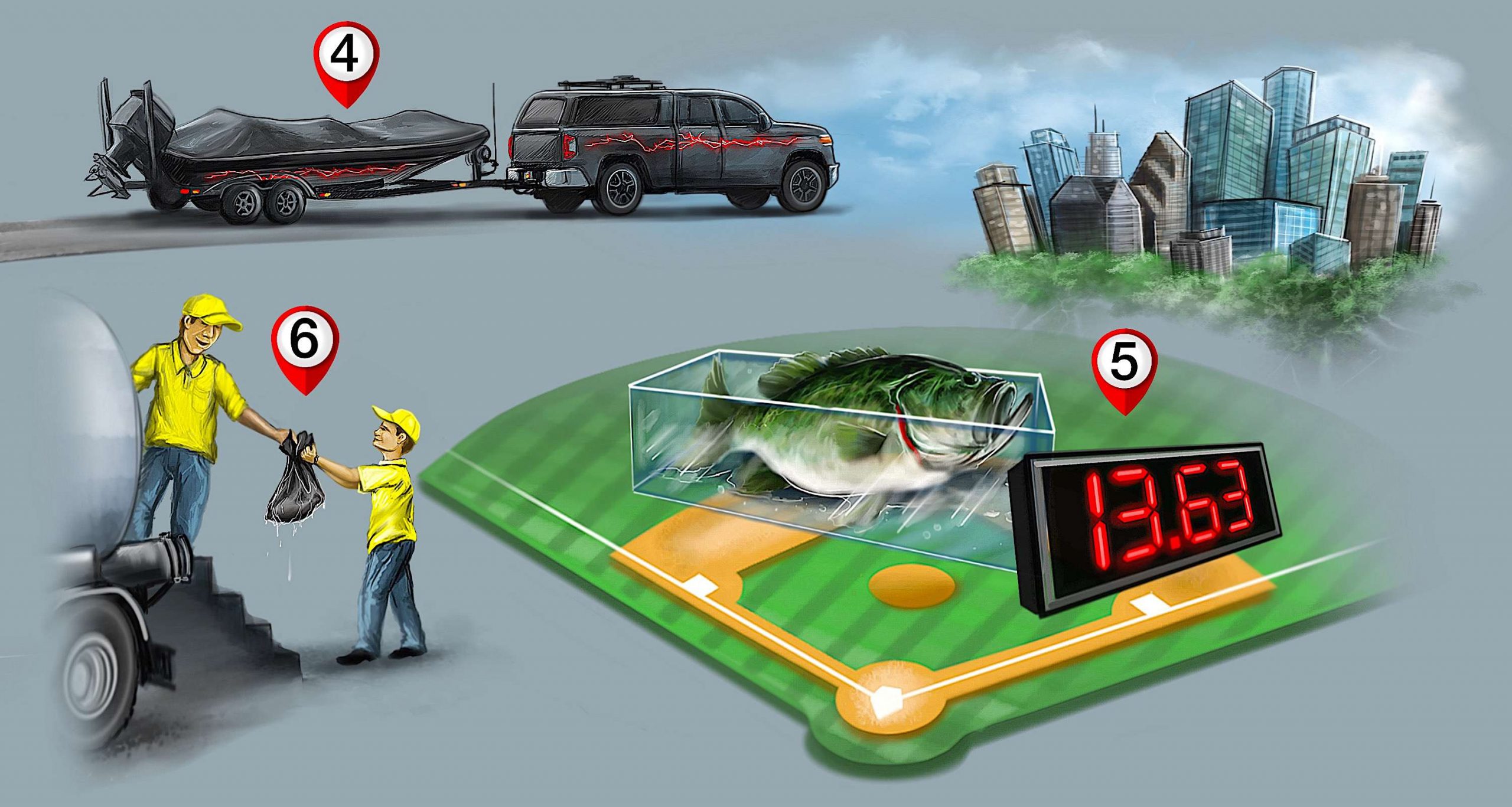
Extreme measures will keep fish safe during Classic
HOUSTON, Texas – B.A.S.S. provides the absolute best fish care possible at every event it holds, from the Costa Bassmaster High School Series all the way up to the Bassmaster Elite Series.
But at the 2017 GEICO Bassmaster Classic presented by DICK’S Sporting Goods March 24-26, the measures will be even more extreme with the anglers and their catch facing a 43-mile commute from Lake Conroe back to Minute Maid Park in Houston.
The stadium is the home of Major League Baseball’s Houston Astros – and since the Astros have a home game scheduled just three days after the Classic, anglers and fish alike must remember to keep off the grass at the Minute Maid Park. But B.A.S.S. officials insist that won’t keep the organization from continuing its excellent record of fish survival at Classic venues, which typically is 97 to 100 percent, according to National Conservation Director Gene Gilliland.
“We certainly expect to achieve the same level of success at Lake Conroe,” Gilliland said. “Every Classic – every situation – is different. But getting those fish safely back to Lake Conroe is our top priority.”
The fish care measures will begin with the 52 anglers competing at 21,000-acre Conroe. Since most of them make their livings catching fish – and none of them wants to incur the 4-ounce penalty charged for weighing a dead fish – they’ll take extreme measures to keep the fish healthy while they’re in their livewells.
“Our anglers are very conscientious when it comes to keeping their fish alive,” Gilliland said. “Dead fish mean penalties and, in the most important bass tournament in the world, they don’t want any deductions.”
That point was emphasized in 1997 when amateur angler Dalton Bobo lost the Classic to veteran pro Dion Hibdon by 1 ounce. Bobo was penalized 4 ounces for weighing a dead fish on the final day.
That 1997 Classic was held during the heat of the summer, but the conditions should be much milder for a late March Classic – even in Texas.
When competitors return to Lake Conroe Park for afternoon takeout and the 43-mile trip to Minute Maid Park, they will be met by B.A.S.S. staff, as well as state conservation directors from the B.A.S.S. Nation who have volunteered and been trained to help.
First, they will look for dead fish and make sure bass meet the legal minimum length of 16 inches for largemouth and 14 inches for smallmouth. They will also check to make sure livewells are full and the recirculating aerators are on full time to maximize oxygen in the water.
“If water temperatures are above 70 degrees, we will add a little ice to help stabilize the temperature for the trip to Houston,” Gilliland said. “It’s not so much to cool the water as it is to maintain it.”
Barring a cold front, that’s likely to be the case. Lake Conroe water temperatures that time of year typically are in the mid- to upper 70s.
Once the fish are settled, the drivers will take the anglers, their boats, and fish to the ballpark, which will likely take at least an hour. If, as expected, they are allowed to use an inbound HOV (high occupancy vehicle) lane on Interstate-45, travel time could be shortened a bit.
An hour’s drive is more the norm than the exception for a Classic. It was the case during the 2014 Classic held on Alabama’s Lake Guntersville when weigh-ins were held an hour away in Birmingham, and again last year when the Classic was held on Grand Lake o’ the Cherokees with weigh-ins 90 minutes away back in Tulsa.
“It’s certainly nothing we haven’t experienced before,” Gilliland said. “We just want people to know the fish get the best care possible on those trips – and we’re extremely proud of our survival rate.”
Outside Minute Maid Park, the fish will be checked again by B.A.S.S. staff and volunteers, more ice will be added if necessary and the boats will be washed. Anglers will place their bass in mesh bags, which stay in the livewells.
When the weigh-in begins, each boat will enter the stadium from right field. It will drive onto the warning track and, from there, travel on an elevated platform down the right field line, go around home plate, and stop at third base.
“The stage will be set on the baseball infield between second and third base, facing the third base line and stands,” Gilliland said. “There will be a bridge there for anglers to cross over the grass and carry their bags of fish to the stage and scales.”
At a Classic, bass typically are kept out of the water less than a minute total from the time the anglers check in at the takeout site until they are released back into their home waters after the weigh-in. The longest part of that is when the fisherman carries his catch in a mesh bag to the stage.
“That time out of the water is usually 10 to 20 seconds at a time,” Gilliland said. “For the Elite tournaments, the average total time was 49 seconds. We want to handle the fish as little as possible and keep them out of the water as little as possible. At the ramp, they might not even need to be handled and the same goes for the boatyard.”
Occasionally, anglers will take bigger fish out of the mesh and hold them up for the crowd and media to see. As the remainder of the bass are passed off so that they can be more quickly placed in water, those photo fish will receive a few extra seconds in the spotlight before being placed in separate bags and moved along in the process.
For this Classic, the bass will be hustled out of Minute Maid Park to hatchery hauling trailers provided by the Texas Parks and Wildlife Department (TPWD).
“The most common question we get is ‘Will those fish go home?’ and they will,” Gilliland said. “People who live around lakes are possessive of their fish and we understand that.”
For this Classic, the exception would be a ShareLunker (13 pounds or better), which would go to the hatchery in Athens. The TPWD ShareLunker Program encourages anglers who catch a fish that weighs 13 pounds or more to donate it for spawning purposes.
All other bass will be transported in the TPWD trailers each evening to Conroe where they will be released at undisclosed locations, according to Dave Terre, chief of management/research for Inland Fisheries.
“I will staff those with four people,” Terre said. “I will likely have two other fish transport vehicles as well. Each of those vehicles will have a staff member assigned to them.”
Water in the trailers will be oxygenated and temperature maintained as close as possible to that of Lake Conroe, Gilliland said.
The conservation director added that the entire fish care process from takeout to placement in the hatchery trailers requires 10 to 12 B.A.S.S. staff and volunteers.
“Space is tight and time is tight,” Gilliland said. “That’s all we need to keep the process moving, to handle the fish as little as possible and get them back to the lake.”







